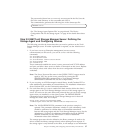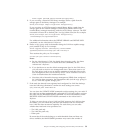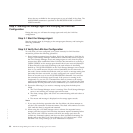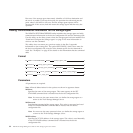define stgpool apoolname adeviceclassname pooltype=primary
5. If you are using a shared ACSLS library manager, define a path from the
storage agent to the library manager. For example:
define path storagnt libmgr1 srctype=server desttype=library
If you are using an ACSLS-managed external library, define a path from the
storage agent to the external manager. Gresham EDT-DistribuTAPE is the
external library manager interfacing with the ACSLS library software. The EDT
executable is located in its default path /usr/lpp/dtelm/bin/elm For example:
define path storagnt stk-lib srctype=server desttype=library
externalmanager=/usr/lpp/dtelm/bin/elm
For additional information about the DEFINE LIBRARY and DEFINE PATH
commands, see the Administrator’s Reference.
6. Define a copy group with its destination being the LAN-free capable storage
pool (created in Step 4). For example:
define copygroup sandirect sandirectpolicy sandirectdefmft
type=backup destination=<storage pool name from Step 3>
Then activate the policy set. For example:
activate policyset sandirect sandirectpolicy
Notes:
a. See the Administrator’s Guide for details about changing policy for clients
that can use SAN drives. For details about the commands, see the
Administrator’s Reference.
b. If you decide not to use the default management class for the SAN drives,
you will need to create a new management class. Clients that want to use
the SAN drives need to use an include statement to bind their files to this
new management class. See the Backup-Archive Clients Installation and User’s
Guide for details about the include-exclude list.
c. Note that with a hierarchical storage management (HSM) client configured
for LAN-free data movement, the management class (not the copy group) is
set to a LAN-free capable storage pool.
7.
If the node has already been registered and configured for LAN-free backups,
issue the following command to confirm the node settings are correct:
query node node_name format=detailed
You can issue the UPDATE NODE command to adjust settings for your node. If
the node has not been registered and configured for LAN-free backups, register
the node with the REGISTER NODE command. For more information, see the
REGISTER NODE and UPDATE NODE commands in the Administrator’s
Reference.
To help you tune the use of your LAN and SAN resources for LAN-free data
movement, you can control the path that data transfers take for clients that
have LAN-free data movement capability. For each client, you can select
whether data read and write operations use:
v The LAN path only
v The LAN-free path only
v Either path
Be aware that if the node belongs to a multi-threaded client and there are
drives available, the MAXNUMMP parameter may restrict the number of
Chapter 4. Installing and Configuring External Library Environments 39


















